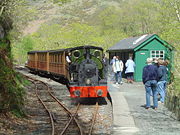
Nant Gwernol railway station
Encyclopedia

Talyllyn Railway
The Talyllyn Railway is a narrow-gauge preserved railway in Wales running for from Tywyn on the Mid-Wales coast to Nant Gwernol near the village of Abergynolwyn. The line was opened in 1866 to carry slate from the quarries at Bryn Eglwys to Tywyn, and was the first narrow gauge railway in Britain...
near Abergynolwyn
Abergynolwyn
Abergynolwyn is a village in southern Gwynedd, Wales, located at the confluence of the Nant Gwernol and the Afon Dysynni.Historically, the village was part of Merionethshire and its main industry was slate quarrying and the village was founded in the 1860s to house workers at the nearby Bryn...
, Gwynedd
Gwynedd
Gwynedd is a county in north-west Wales, named after the old Kingdom of Gwynedd. Although the second biggest in terms of geographical area, it is also one of the most sparsely populated...
in mid-Wales
Wales
Wales is a country that is part of the United Kingdom and the island of Great Britain, bordered by England to its east and the Atlantic Ocean and Irish Sea to its west. It has a population of three million, and a total area of 20,779 km²...
. It is 7 miles, 28 chain
Chain (unit)
A chain is a unit of length; it measures 66 feet or 22 yards or 100 links . There are 10 chains in a furlong, and 80 chains in one statute mile. An acre is the area of 10 square chains...
s (11.83km) from .
Nant Gwernol (Alder Stream) station was opened in 1976, at the foot of the former incline to Bryn Eglwys
Bryn Eglwys
Bryn Eglwys was a remote slate quarry located near Abergynolwyn in Gwynedd mid-Wales.- History :The quarry was first worked on a small scale in the early 1840s. In 1864 William McConnel leased the quarry, forming the Aberdovey Slate Company Limited. McConnel planned to increase production at Bryn...
slate quarry
Slate industry in Wales
The slate industry in Wales began during the Roman period when slate was used to roof the fort at Segontium, now Caernarfon. The slate industry grew slowly until the early 18th century, then expanded rapidly until the late 19th century, at which time the most important slate producing areas were in...
- previously the upper part of the line had not been used for passenger services. Trains only wait at the station long enough for the locomotive to run round, as there are no facilities at that point. Instead, most trains pause at station on the return journey to allow passengers time for refreshments. There is no road access to the station, though several footpaths lead off up the incline or towards Abergynolwyn.

